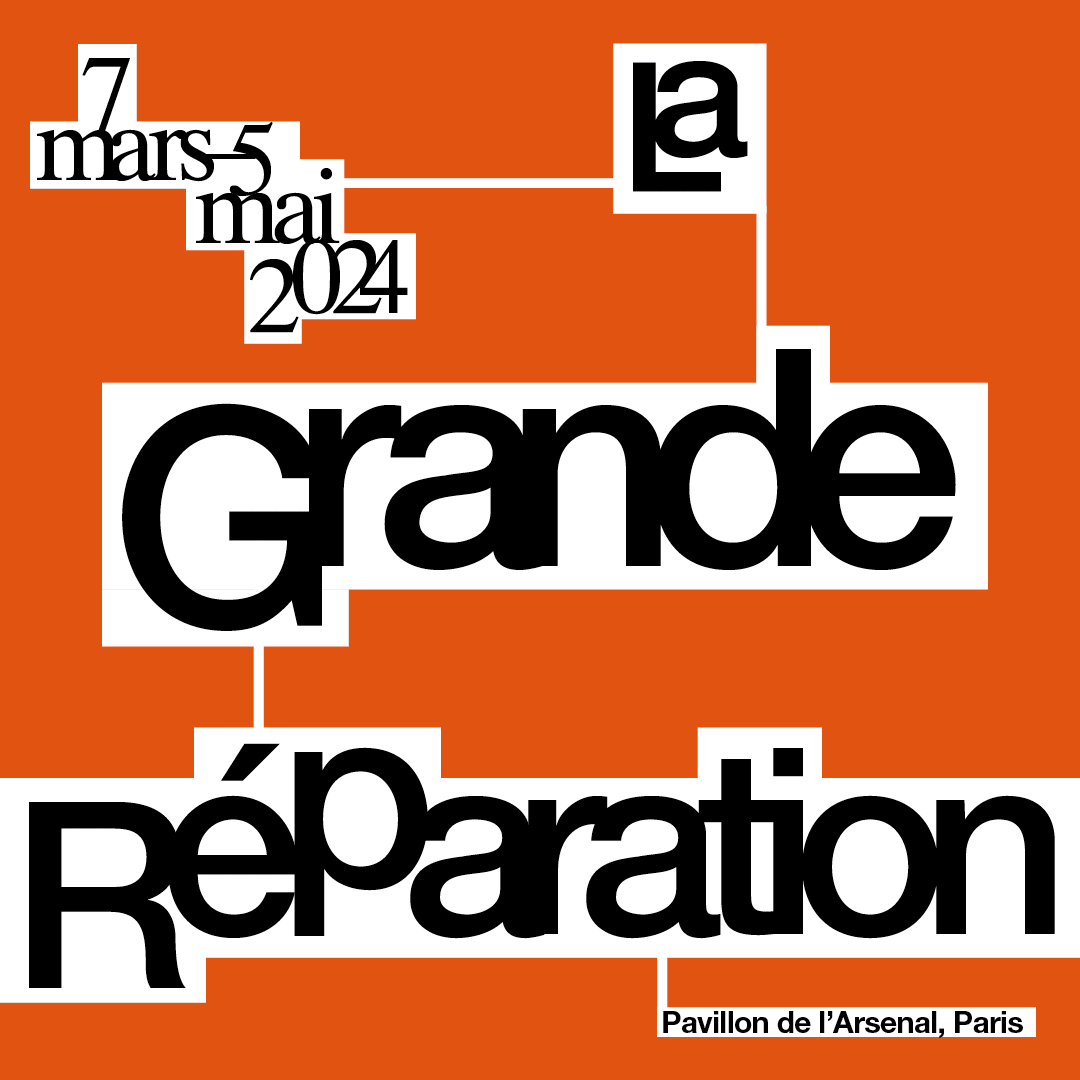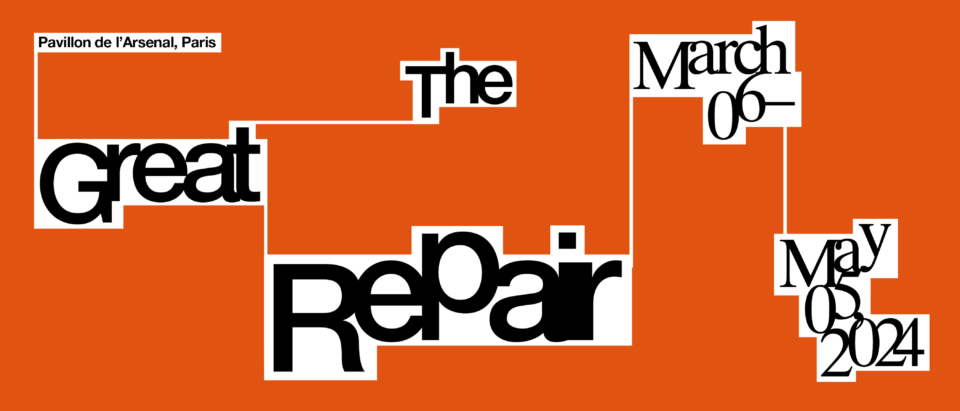
Ausstellung vom 7. März 2024 bis zum 5. Mai 2024 im Pavillon de l’Arsenal, 21 Bd Morland, 75004 Paris
Eröffnung am Mittwoch, den 6. März 2024, 16:30 – 19:45 Uhr, Pavillon de l’Arsenal, 21 Bd Morland, 75004 Paris
Zur Anmeldung
On the occasion of the exhibition’s opening on March 6, 2024, the “School of Repair” will be held at Pavillon de l’Arsenal from 4:30 p.m. to 7 p.m. Several contributors to the exhibition will present their work and engage with the public about their practice.
School of Repair program (Opening):
4:30 p.m. – Bas Princen: Giotto’s Fragments (EN)5:00 p.m. – Camille Sineau (Assemble): Methods of Assembly (FR)
5:00 p.m. – Marion Moutal & Akshar Gajjar (THEMA):Concrete: Cosmetic and Care (EN)
5:30 p.m. – Matthias Brenner (chair of Silke Langenberg ETH Zürich): CLA, repair of a high-tech facade (EN)
5:30 p.m. – Florian Hertweck (artistic direction The Great Repair): Repairing a Commercial Zone (FR)
6:00 p.m. – Folke Köbberling: Cars into Bicycles (EN)
6:00 p.m. – Milica Topalovic (artistic direction The Great Repair): Power to the People (EN)
6:30 p.m. – Bettina Knaup: curating Mierle Laderman Ukeles’ MANIFESTO FOR MAINTENANCE ART, 1969! Proposal for an Exhibition „CARE“ & Touch Sanitation (EN)
6:30 p.m. – Charlotte Malterre-Barthes: A GlobalMoratorium on New Construction (FR)
Opening Ceremony:
7:20 p.m. – Inaugural speeches
7:45 p.m. – Free entrance to the exhibition
Exhibition produced by Pavillon de l’Arsenal and designed by ARCH+ in partnership with Akademie der Künste Berlin, Department of Architecture ETH Zürich and Master in Architecture University of Luxembourg.
In a world scarred by the exploitation of resources and people and torn apart by wars, architecture can serve as a reparative force. Fueled by this belief, Pavillon de l’Arsenal presents the exhibition “The Great Repair,” a traveling project initiated by ARCH+ in collaboration with Akademie der Künste in Berlin, ETH Zürich, and the University of Luxembourg. Its aim, in light of the stark realization of the irreconcilable conflict between unchecked growth and ecological balance, is to advocate for a new architectural ethos centered around repair.
From the care provided by often-marginalized workers in maintaining buildings, to the political decision to refrain from demolition, and to architecture as an instrument of justice in times of conflict, the exhibition challenges the ethical stance of contemporary builders. In a time of ecological and social emergency, every choice to build, not to build, or to build in a different way can either result in the destructive use of resources harming the planet and its denizens or to genuine repair. The exhibition seeks to explore the line between the two to better understand how to practice architecture ethically in today’s world.
The exhibition is structured around seven topics, shedding light on the processes related to the maintenance and upkeep of architecture and urban landscapes. It examines these themes at various scales, from the daily rituals of caretaking to examples of construction practices that prioritize working with existing structures rather than replacing them with new ones. Through videos, models, installations, original drawings, and prototypes, the exhibition showcases over twenty approaches from both emerging and established international artists and architectural firms that render repair tangible as a new design paradigm.
The European and global dimensions of the project are of paramount importance to us; when confronted with such challenges, the only viable response is a collective one, and dialogue between cultural institutions from different countries is therefore necessary. Proposals originating in Berlin, Mariupol, and Accra inform initiatives in Paris, just as Paris leads the way in advancing a more environmentally and socially conscious architecture.
When considered through the lens of repair, architecture also becomes accessible to everyone as the scale of care extends beyond the realm of professionals, allowing everyone to get involved in repairing their immediate surroundings and any injustices they observe there. Let’s repair!
With contributions by:
Assemble, Atelier Bow-Wow, Brenne Architekten with Jana Hainbach / TU München / HfBK Dresden / Akademie der Künste Baukunstarchiv, Matthias Brenner, Center for Spatial Technologies, Agnes Denes, Studio Anna Heringer, Florian Hertweck & Caroline Faber & Marija Marić & Céline Zimmer / Master in Architecture at the University of Luxembourg, Interboro with Center for Justice Innovation & Patterson Houses NeighborhoodStat Team & Richard A. Chance & Coco McPherson, Folke Köbberling & Martin Kaltwasser, Lacaton & Vassal, Silke Langenberg, Limbo Accra, Charlotte Malterre-Barthes, Material Cultures, Fuminori Nousaku & Mio Tsuneyama, Bas Princen, Alexander Stumm, Takhayali, Paulo Tavares, THEMA (Sarah Nichols, Akshar Gajjar, Marion Moutal) with Syn Liu, Milica Topalović / Architecture of Territory ETH Zürich, Mierle Laderman Ukeles (curated by Bettina Knaup), UVW-SAW
Exhibition run: March 7 to May 5, 2024 – Free admission
Artistic direction: Florian Hertweck, Christian Hiller, Markus Krieger, Alex Nehmer, Anh-Linh Ngo, Milica Topalović
Associate curators: Marija Marić, Nazlı Tümerdem
Production manager: Felix Hofmann
Event programming: Markus Krieger, Daniel Kuhnert
Team: Elke Doppelbauer, Nora Dünser, Mirko Gatti, Arno Löbbecke, Victor Lortie, Mona Rauch, Lea Scherer, Barbara Schindler
Graphic design: Stan Hema
The project is funded by:
Kulturstiftung des Bundes (German Federal Cultural Foundation)
German Federal Government Commissioner for Culture and the Media
Supported by:
Federal Foreign Office
Wüstenrot Foundation
Federal Agency for Civic Education (bpb)
Hans Sauer Foundation
Kultur | lx – Arts Council Luxembourg
Photo credits:
Photo 1: Djenné Mosque, 2010 © Bas Princen
Photo 2: Holes in the House © Ryogo Utatsu
Photo 3: Power to the People, Protests at Hambach © Architecture of Territory, ETH Zuerich
